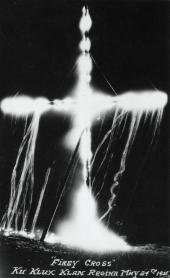

The Knights of the Ku Klux Klan, originated in Tennessee in the early years of the Reconstruction Era following the American Civil War, soon became synonymous with all the most sinister elements of life in the South, and faded from the scene until its resurrection at the time of World War I. In the early 1920s it spread across the United States into Canada, and in late 1926 Klan organizers came to Saskatchewan to preach its message of racial and religious hatred and to sell expensive memberships to fund its activities. The first American Klansmen absconded with the treasury late in 1927, but by this time sufficient local people had taken out memberships to take over the leadership of the organization. By the fall of 1928 local Klans had been established in over 100 Saskatchewan towns, usually signalling themselves by a ritual burning of crosses; their leaders claimed an overall membership of some 40,000, who had been attracted by the Klan's attacks on the “unassimilable” immigrants from central and southeastern Europe and on the Roman Catholic church for its “subversion” of the public school system. These attacks revived ancient prejudices dormant for years, spread animosity and suspicion across the province, and threatened groups friendly to the Liberal Party. Thus, Premier J.G. Gardiner led a counterattack on the Klan from the summer of 1928 onward, accusing it not only of disrupting social harmony in Saskatchewan but also of being a tool of the Conservative Party. Both the Klan and J.T.M. Anderson, the Conservative leader, denied the charge, pointing out that the Klan membership contained known Liberals and Progressives as well as Conservatives, and that no proof existed of an alliance between the Klan and any political party. Nevertheless, both the Conservative and Progressive parties raised issues during the 1929 election campaign which drew upon the emotions aroused by the Klan and captured enough votes from the Anglo-Saxon and Protestant sector of the electorate to defeat the Liberals. The Klan convention in 1930 applauded the Anderson government's amendments to the School Act and its new immigration policy, and some local Klans remained active until the worst of the Depression struck the province. In these circumstances, the Knights of the Invisible Empire became truly invisible throughout Saskatchewan and did not reappear for another fifty years.
Patrick Kyba